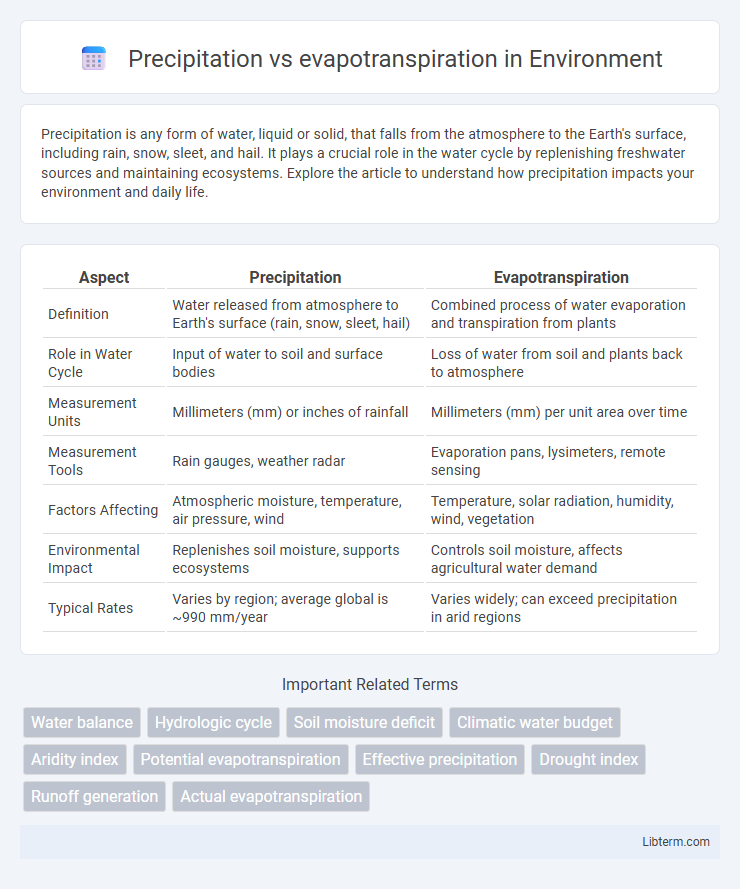Precipitation is any form of water, liquid or solid, that falls from the atmosphere to the Earth's surface, including rain, snow, sleet, and hail. It plays a crucial role in the water cycle by replenishing freshwater sources and maintaining ecosystems. Explore the article to understand how precipitation impacts your environment and daily life.
Table of Comparison
| Aspect | Precipitation | Evapotranspiration |
|---|---|---|
| Definition | Water released from atmosphere to Earth's surface (rain, snow, sleet, hail) | Combined process of water evaporation and transpiration from plants |
| Role in Water Cycle | Input of water to soil and surface bodies | Loss of water from soil and plants back to atmosphere |
| Measurement Units | Millimeters (mm) or inches of rainfall | Millimeters (mm) per unit area over time |
| Measurement Tools | Rain gauges, weather radar | Evaporation pans, lysimeters, remote sensing |
| Factors Affecting | Atmospheric moisture, temperature, air pressure, wind | Temperature, solar radiation, humidity, wind, vegetation |
| Environmental Impact | Replenishes soil moisture, supports ecosystems | Controls soil moisture, affects agricultural water demand |
| Typical Rates | Varies by region; average global is ~990 mm/year | Varies widely; can exceed precipitation in arid regions |
Understanding Precipitation: Definition and Types
Precipitation refers to any form of water, liquid or solid, that falls from the atmosphere to the Earth's surface, including rain, snow, sleet, hail, and drizzle. It plays a crucial role in the hydrological cycle by replenishing surface water and groundwater, influencing soil moisture and ecosystem health. Understanding the different types of precipitation helps in predicting weather patterns and managing water resources effectively.
What is Evapotranspiration? Core Concepts Explained
Evapotranspiration refers to the combined process of water evaporation from soil and plant surfaces, along with transpiration through plant stomata. This key hydrological mechanism plays a vital role in the water cycle by transferring moisture from land to atmosphere, influencing weather patterns and agricultural water use. Monitoring evapotranspiration rates helps optimize irrigation practices and manage water resources for sustainable crop production.
The Water Cycle Connection: Linking Precipitation and Evapotranspiration
Precipitation and evapotranspiration are critical components of the hydrological cycle, where precipitation delivers water to the Earth's surface and evapotranspiration returns it to the atmosphere through evaporation and plant transpiration. The balance between these processes controls soil moisture levels, influences groundwater recharge, and regulates regional climate patterns. Understanding their dynamic interaction is essential for water resource management, agriculture, and predicting climate change impacts on the water cycle.
Measuring Precipitation and Evapotranspiration: Methods and Tools
Measuring precipitation relies on tools such as rain gauges, weather radar, and satellite observations to quantify the amount of water falling as rain, snow, or hail. Evapotranspiration measurement involves methods like lysimeters, eddy covariance systems, and remote sensing technologies to assess water loss from soil and plant surfaces through evaporation and transpiration. Accurate data collection from these methods is essential for hydrological studies, agricultural management, and climate modeling.
Key Differences Between Precipitation and Evapotranspiration
Precipitation refers to the process where water in the atmosphere condenses and falls to the Earth's surface as rain, snow, sleet, or hail, whereas evapotranspiration combines evaporation from soil and plant surfaces with transpiration from vegetation into the atmosphere. Precipitation adds water to the terrestrial ecosystem, influencing soil moisture and water availability, while evapotranspiration represents water loss from the surface, affecting local climate and hydrological balance. Key differences include their roles in the water cycle, direction of water movement, and impact on ecosystem water budgets.
Importance in Hydrology: Impacts on Water Resources
Precipitation and evapotranspiration are critical components of the hydrological cycle, directly influencing water availability and distribution in ecosystems. Precipitation replenishes surface and groundwater supplies, while evapotranspiration regulates water loss through evaporation and plant transpiration, affecting soil moisture levels and streamflow. Understanding the balance between these processes is essential for managing water resources, predicting droughts, and supporting sustainable agriculture and urban planning.
Environmental Factors Influencing Both Processes
Environmental factors such as temperature, humidity, and wind speed significantly influence both precipitation and evapotranspiration rates by affecting atmospheric moisture capacity and surface water availability. Vegetation type and soil characteristics also play crucial roles, as dense plant cover increases transpiration while soil composition impacts water retention and evaporation. Topography and geographic location determine the distribution and intensity of precipitation events, directly impacting the balance between incoming and outgoing water fluxes in ecosystems.
Precipitation vs Evapotranspiration in Climate Change Context
Precipitation and evapotranspiration are critical components of the hydrological cycle, with precipitation representing water input and evapotranspiration indicating water loss through evaporation and plant transpiration. In the context of climate change, altered precipitation patterns and increased temperatures intensify evapotranspiration rates, disrupting water availability and soil moisture balance. This imbalance contributes to more frequent droughts, reduced agricultural productivity, and heightened stress on ecosystems globally.
Applications in Agriculture and Land Management
Precipitation and evapotranspiration are critical metrics for optimizing irrigation schedules and managing soil moisture in agriculture, directly impacting crop yield and water-use efficiency. Monitoring these parameters enables precise water resource management, reducing over-irrigation and preventing soil degradation in land management practices. Remote sensing and climate models integrate precipitation and evapotranspiration data to support sustainable agricultural planning and drought mitigation strategies.
Balancing Precipitation and Evapotranspiration: Implications for Sustainability
Balancing precipitation and evapotranspiration is essential for sustainable water resource management and maintaining ecosystem health. When precipitation exceeds evapotranspiration, water surplus supports groundwater recharge and agricultural productivity, whereas a deficit can lead to soil moisture depletion and increased drought risk. Optimizing this balance through climate monitoring and water-efficient practices ensures long-term environmental stability and resilience against climate change impacts.
Precipitation Infographic

 libterm.com
libterm.com